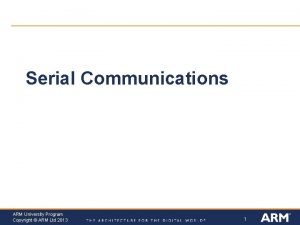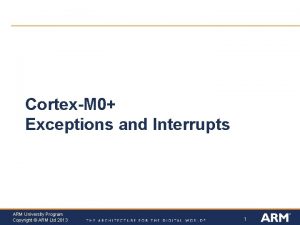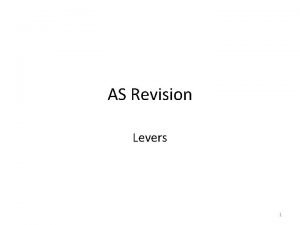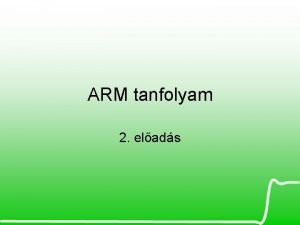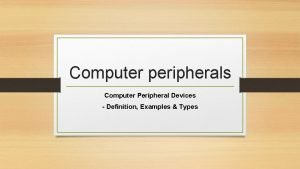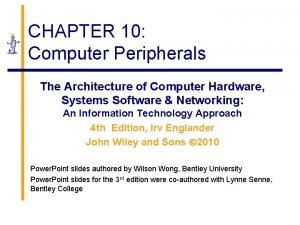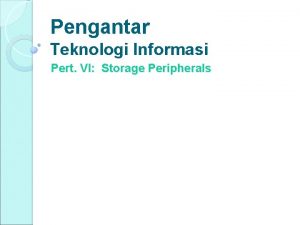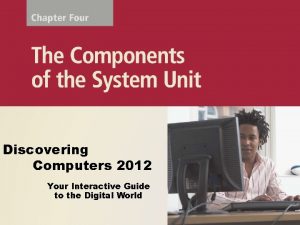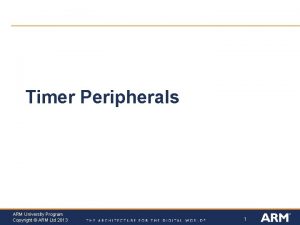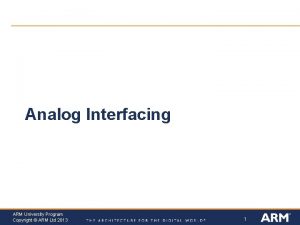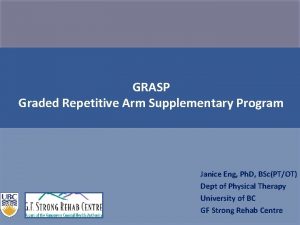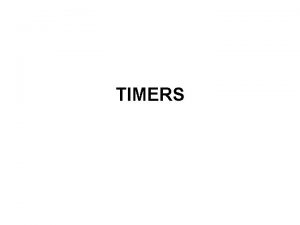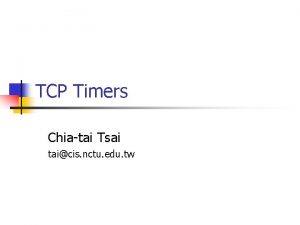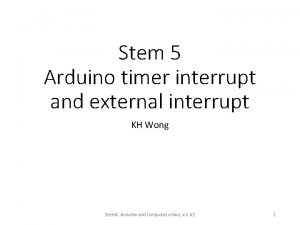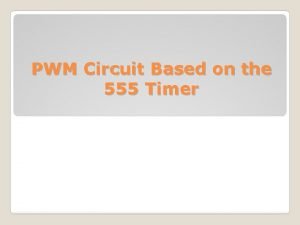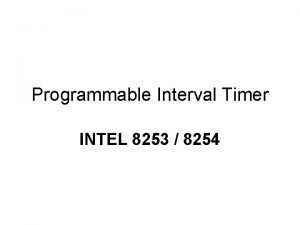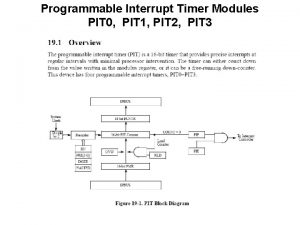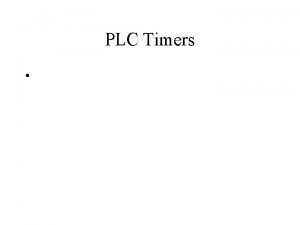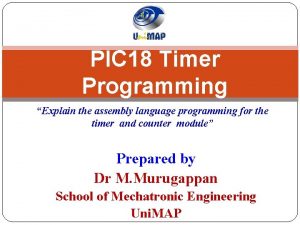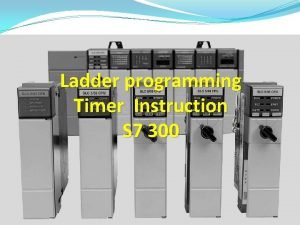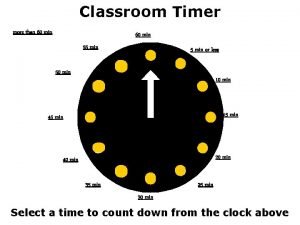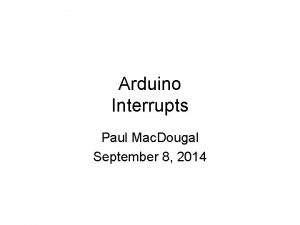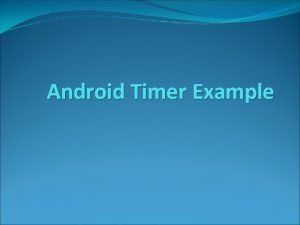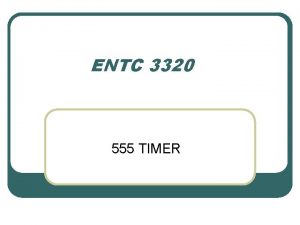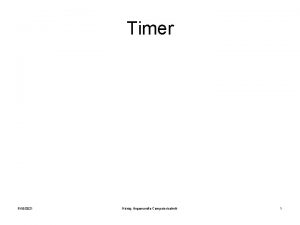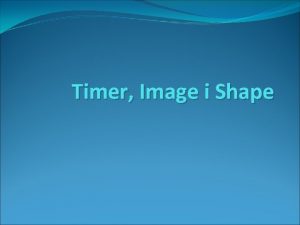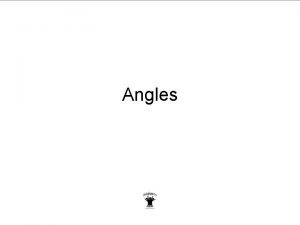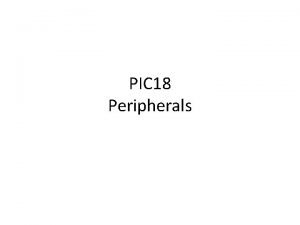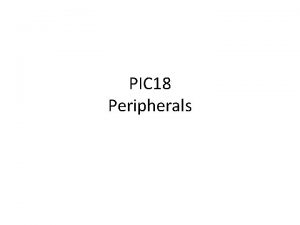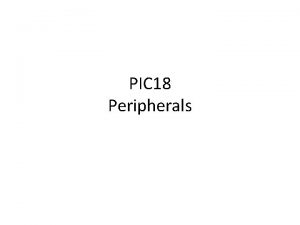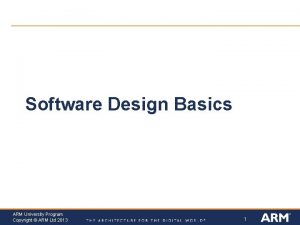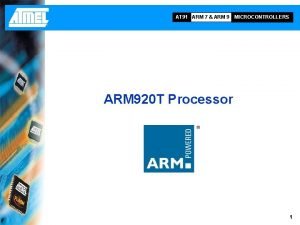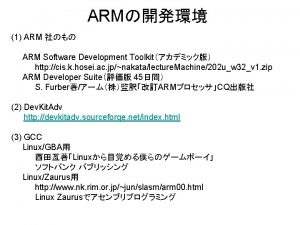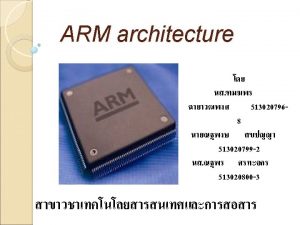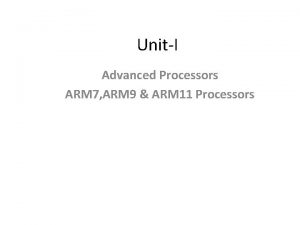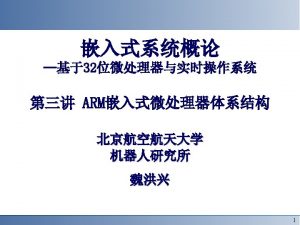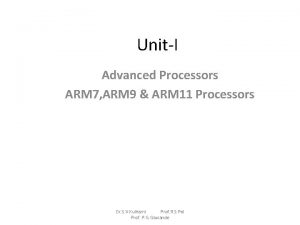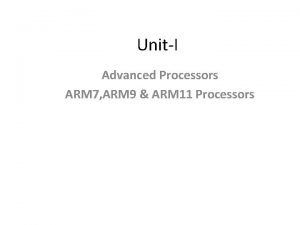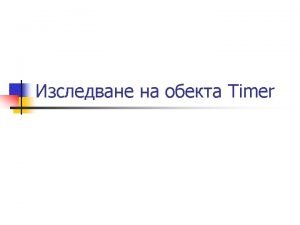Timer Peripherals ARM University Program Copyright ARM Ltd
























![Capture/Compare Mode Register 1 § § [0: 7] bits are for channel 1, [8: Capture/Compare Mode Register 1 § § [0: 7] bits are for channel 1, [8:](https://slidetodoc.com/presentation_image/004d57cac3f3966362a45919d1200f31/image-25.jpg)









- Slides: 34

Timer Peripherals ARM University Program Copyright © ARM Ltd 2013 1

STM 32 F 4 Clock tree § Various Clock sources § Highly configurable § Can be controlled independently § Possible to prescale § Can output clock from some pins § To achieve the balance between performance and power consumption ARM University Program Copyright © ARM Ltd 2013 2

Timer/Counter Peripheral Introduction Events Reload Value or Presettable Binary Counter Clock Reload ÷ 2 or RS PWM Interrupt § § Current Count Common peripheral for microcontrollers Based on presettable binary counter, enhanced with configurability § § Count value can be read and written by MCU Count direction can often be set to up or down Counter’s clock source can be selected § § Counter mode: count pulses which indicate events (e. g. odometer pulses) Timer mode: clock source is periodic, so counter value is proportional to elapsed time (e. g. stopwatch) Counter’s overflow/underflow action can be selected § § Generate interrupt Reload counter with special value and continue counting Toggle hardware output signal Stop! ARM University Program Copyright © ARM Ltd 2013 3

STM 32 F 4 Timer Peripherals § § § Advanced Control Timer § TIM 1 and TIM 8 § Input capture, output compare, PWM, one pulse mode § 16 -bit auto-reload register § Additional control for driving motor or other devices General Purpose Timer § TIM 2 to TIM 5 § Input capture, output compare, PWM, one pulse mode § 16 -bit or 32 -bit auto-reload register General Purpose Timer § TIM 9 to TIM 14 § Input capture, output compare, PWM, one pulse mode § Only 16 -bit auto-reload register Basic Timer (Simple timer) § TIM 6 and TIM 7 § Can be generic counter and internally connected to DAC § 16 -bit auto reload register Also a 24 bit system timer(Sys. Tick) ARM University Program Copyright © ARM Ltd 2013 4

General Purpose Timer Block Diagram ARM University Program Copyright © ARM Ltd 2013 5

General Purpose Timer Reload Value Reload Clock TIMx_PSC TIMx_CNT TIMx_ARR Interrupt ISR Resume Current Count § § Timer can count down or up/down (up by reset) A prescaler can divide the counter clock 4 independent channels for the timer § § Input capture Output compare PWM generation One-pulse mode output Overflow or underflow will cause an update event (UEV), thus the interrupt and possibly the reload ARM University Program Copyright © ARM Ltd 2013 6

General Purpose Timer Control Registers § Highly Configurable ARM University Program Copyright © ARM Ltd 2013 7

PERIODIC INTERRUPT ARM University Program Copyright © ARM Ltd 2013 8

Timer as A periodic Interrupt Source Reload Value Reload Clock TIMx_PSC TIMx_CNT TIMx_ARR Interrupt ISR Resume Current Count § § § STM 32 F 4 families enjoy sophisticated and powerful timer One of the basic function of the timer is to cause independent and periodic interrupts Best for regularly repeating some certain small tasks ARM University Program Copyright © ARM Ltd 2013 9

General Purpose Timer Control Registers § Highly Configurable § Only few need to be configure for periodic interrupt setup ARM University Program Copyright © ARM Ltd 2013 10

General Purpose Timer Clock selection § There are 4 possible sources of clock § § § § Internal clock(CK_INT) External clock mode 1: external input pin(TIx) External clock mode 2: external trigger input (ETR) (some timers only) Internal trigger inputs (ITRx) Access TIMx_SMCR (Bit 2: 0 SMS) slave mode control register to select the clock source and mode For example, for the periodic interrupt, with SMS being 000, the counter will clocked by the internal clock (APB 1) By default, the prescaler for APB 1 is 4 (defined by the system_stm 32 f 4 xx. c), which means the CK_INT is 42 Mhz (SYSCLK is 168 Mhz) ARM University Program Copyright © ARM Ltd 2013 11

Specify PSC and ARR Reload Value Reload Clock TIMx_PSC TIMx_CNT TIMx_ARR Interrupt ISR Current Count § ARM University Program Copyright © ARM Ltd 2013 12 Resume

More on PSC and ARR Reload Value Reload Clock TIMx_PSC TIMx_CNT TIMx_ARR Interrupt ISR Resume Current Count § Accessing the ARR only write or read from a preload register of ARR, there is another shadow register which is the register that actually performs the reloading. The content of the preload register will be transfer to the shadow register permanently if the APRE bit in TIMx_CR 1 is clear or at each UEV if APRE bit is set. § PSC, on the other hand, is always buffered. Which means though it can be changed on the fly, the new ratio will only be taken into account at the next UEV. ARM University Program Copyright © ARM Ltd 2013 13

Initialize the TIM 2 with CMSIS § Enable clock to Timer 2 RCC->APB 1 ENR|=RCC_APB 1 ENR_TIM 2 EN; § Set the auto-reload TIM 2 ->ARR=arr; § Set the prescaler TIM 2 ->PSC=psc; § Enable the update interrupt TIM 2 ->DIER|=TIM_DIER_UIE; § Enable counting TIM 2 ->CR 1|=TIM_CR 1_CEN ARM University Program Copyright © ARM Ltd 2013 14

Interrupt Handler § Enable the interrupt __enable_irq() ; § CMSIS ISR name: TIM 2_IRQHandler NVIC_Enable. IRQ(TIM 2_IRQn); § ISR activities § Clear pending IRQ NVIC_Clear. Pending. IRQ(TIM 2_IRQn); § § Do the ISR’s work Clear pending flag for timer TIM 2 ->SR&=~TIM_SR_UIF; ARM University Program Copyright © ARM Ltd 2013 15

Sys. Tick as Periodic Interrupt Source § Alternatively, we can use the Sys. Tick provided by Cortex. M 4 core to generate exactly the same periodic interrupt. § § The configuration of Systick is however much simpler. Four registers: § Since this is part of the core, it is fully supported by CMSIS § § § Sys. Tick_Config(uint 32_t ticks) Initialize the Systick Sys. Tick_Config(System. Core. Clock / 1000) makes 1 ms 168 M/1000*(1/f)= 1 ms ARM University Program Copyright © ARM Ltd 2013 16

Example: Stopwatch § § § Measure time with 100 us resolution Display elapsed time, updating screen every 10 ms UUse Systick § § Counter increment every 100 us LCD Update every 10 ms § Update LCD every nth periodic interrupt § n = 10 ms/100 us = 100 § Don’t update LCD in ISR! Too slow. § Instead set flag LCD_Update in ISR, poll it in main loop § Usually the ISR is only for update the timer or for delaying (precise timing!) ARM University Program Copyright © ARM Ltd 2013 17

CAPTURE/COMPARE MODE ARM University Program Copyright © ARM Ltd 2013 18

Capture/Compare Channels § Different channels but same blocks § Capture mode can be used to measure the pulse width or frequency § § § Input stage includes digital filter, multiplexing and prescaler Output stage includes comparator and output control A capture register (with shadow register) § Input Stage Example § Input signal->filter->edge detector->slave mode controller or capture command ARM University Program Copyright © ARM Ltd 2013 19

Capture/Compare Channels § Main Circuit § The block is made of one preload register and a shadow register. § § In capture mode, captures are done in shadow register than copied into preload register In compare mode, the content of the preload register is copied into the shadow register which is compared to the counter ARM University Program Copyright © ARM Ltd 2013 20

Capture/Compare Channels § Output stage § Generates an intermediate waveform which is then used for reference. ARM University Program Copyright © ARM Ltd 2013 21

Wind Speed Indicator (Anemometer) § Rotational speed (and pulse frequency) is proportional to wind velocity § Two measurement options: § § Frequency (best for high speeds) Width (best for low speeds) § Can solve for wind velocity v § How can we use the Timer for this? § Use Input Capture Mode to measure period of input signal ARM University Program Copyright © ARM Ltd 2013 22

Input Capture Mode for Anemometer § Operation: Repeat § First capture - on rising edge § Reconfigure channel for input capture on falling edge § Clear counter, start new counting § § Second Capture - on falling edge § Read capture value, save for later use in wind speed calculation § Reconfigure channel for input capture on rising edge § Clear counter, start new counting Solve the wind speed § Vwind = K÷(Cfalling – Crising)×Freq ARM University Program Copyright © ARM Ltd 2013 23

Registers for Anemometer § § § § § TIMx_ARR (Refer to the periodic interrupt) TIMx_PSC (Refer to the periodic interrupt ) TIMx_CCMR 1 Capture/compare mode register 1 (Channel 1 and 2) TIMx_CCMR 2 (for channel 3 and 4) TIMx_CCER Capture/compare enable register TIMx_DIER DMA/interrupt enable register TIMx_CR 1 Control register TIMx_CCRx Capture compare register TIMx_SR Status register ARM University Program Copyright © ARM Ltd 2013 24
![CaptureCompare Mode Register 1 0 7 bits are for channel 1 8 Capture/Compare Mode Register 1 § § [0: 7] bits are for channel 1, [8:](https://slidetodoc.com/presentation_image/004d57cac3f3966362a45919d1200f31/image-25.jpg)
Capture/Compare Mode Register 1 § § [0: 7] bits are for channel 1, [8: 15] bits are for channel 2 § § IC 1 PSC (Input capture 1 prescaler) Set CC 1 S (Capture/compare 1 selection) to 01, configure channel 1 as input and map IC 1 to TI 1 (Only writable when channel is OFF) IC 1 F (Input capture 1 filter) decide sampling frequency and N events needed to validate a transition on the output § For example, if set to 0001, and set to capture rising edge, when rising edge detected, sample the channel twice with the FCK_INT , if they are both high then the capture is validated. ARM University Program Copyright © ARM Ltd 2013 25

Capture/Compare Enable Register § § 3 Bits for each channel and 4 bits in total are reserved § CC 1 E, set to 1 to enable the capture § Also needs to enable the interrupt on capture CC 1 NP/CC 1 P: 00 to be sensitive to rising edge, 01 to be sensitive to falling edge, different meaning in other modes § TIMx_DIER: set CC 1 IE § Finally, enable the counting § Also remember to clear the pending bit(write 0 to TIM_SR_CC 1 IF) in the ISR ARM University Program Copyright © ARM Ltd 2013 26

Configure the GPIO - AF § § Refer to the user manual to make sure which pin is able to connect to the TIM § Configure the GPIO AF register Then configure the GPIO as AF mode, be careful with the pull up or down setting since it should match the setting of edge detection ARM University Program Copyright © ARM Ltd 2013 27

Output Compare Mode § § Control an output waveform or indicating when a period of time has elapsed When a Match occur (CCRx=CNT) § § Generate specific output on corresponding pin Set the CCx. IF(Interrupt status) bit in the SR Generate Interrupt if configured Generate DMA request if configured § Configure steps § § § ARM University Program Copyright © ARM Ltd 2013 Select the counter clock Write the desired data in ARR and CCR registers Enable Interrupt or DMA request if needed Select the output mode Enable the counter 28

PWM MODE ARM University Program Copyright © ARM Ltd 2013 29

Pulse-Width Modulation § Uses of PWM § § § Digital power amplifiers are more efficient and less expensive than analog power amplifiers § Applications: motor speed control, light dimmer, switch-mode power conversion § Load (motor, light, etc. ) responds slowly, averages PWM signal Digital communication is less sensitive to noise than analog methods § PWM provides a digital encoding of an analog value § Much less vulnerable to noise PWM signal characteristics § § § Modulation frequency – how many pulses occur per second (fixed) Period – 1/(modulation frequency) On-time – amount of time that each pulse is on (asserted) Duty-cycle – on-time/period Adjust on-time (hence duty cycle) to represent the analog value ARM University Program Copyright © ARM Ltd 2013 30

Pulse-Width Modulation § § § § Timer also provides the PWM mode, generate a signal with frequency determined by the value of ARR and a duty cycle determined by the CCR. CCMRx_OCx. M bits, 110 (PWM mode 1) 111(PWM Mode 2) (differs in polarity) Enable the corresponding preload register (OCx. PE in TIMx_CCMRx) Enable the auto reload by setting ARPE bit in TIMx. CR 1 Enable the output Ocx in TIMx_CCER CCx. E bit PWM done by comparing TIMx_CCR and TIMx_CNT, i. e. , if TIMx_CCRx≤TIMx_CNT or TIMx_CNT≤TIMx_CCRx then output high or low. Also can be configured as input mode, so that it can measure external PWM. ARM University Program Copyright © ARM Ltd 2013 31

Edge-Aligned § § § CMS bits in TIMx_CR 1 are 00 As long as TIMx_CNT<TIMx_CCRx then the OCXREF is high Select down-counting or up-counting using DIR bit in TIMx_CR 1 ARM University Program Copyright © ARM Ltd 2013 32

Center-Aligned § CMS bits in TIMx_CR 1 are not 00: many possible wave forms ARM University Program Copyright © ARM Ltd 2013 33

PWM to Drive Servo Motor § Servo PWM signal § § 20 ms period 1 to 2 ms pulse width ARM University Program Copyright © ARM Ltd 2013 34
 Arm university
Arm university Arm university program
Arm university program Arm university program
Arm university program Levers used in everyday life
Levers used in everyday life Circlet clasp rpd
Circlet clasp rpd How do machines make work easier
How do machines make work easier How to remember lever classes
How to remember lever classes Linker arm left arm
Linker arm left arm Types of denture clasps
Types of denture clasps Storage peripherals
Storage peripherals Computer peripherals definition
Computer peripherals definition Computer peripherals storage devices
Computer peripherals storage devices Storage peripherals
Storage peripherals Can connect up to 127 different peripherals
Can connect up to 127 different peripherals Arm university
Arm university Arm university
Arm university Graded repetitive arm supplementary program
Graded repetitive arm supplementary program Timer background for zoom
Timer background for zoom Farmtek timer display
Farmtek timer display 555 watchdog timer
555 watchdog timer Timers in plc
Timers in plc Tcp timers
Tcp timers Arduino nano timer interrupt
Arduino nano timer interrupt Linstow
Linstow Pwm using 555
Pwm using 555 8254 modes
8254 modes Programmable interrupt timer
Programmable interrupt timer Retentive timer example
Retentive timer example Pic18 timer
Pic18 timer Pic timer 0
Pic timer 0 Extended pulse timer
Extended pulse timer Buttontimers
Buttontimers Timer 70 minutes
Timer 70 minutes Watchdog timer
Watchdog timer Android timertask example
Android timertask example
